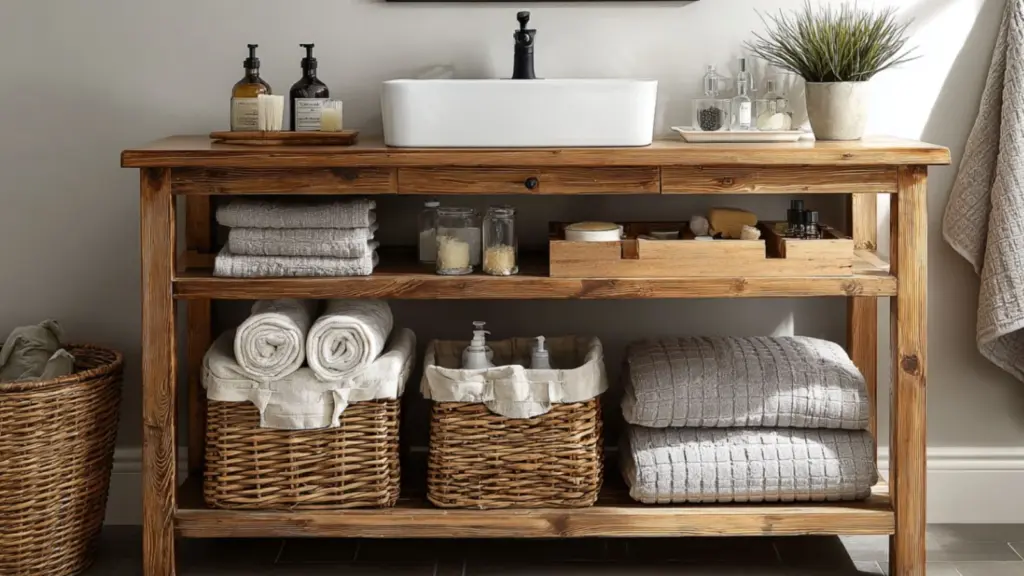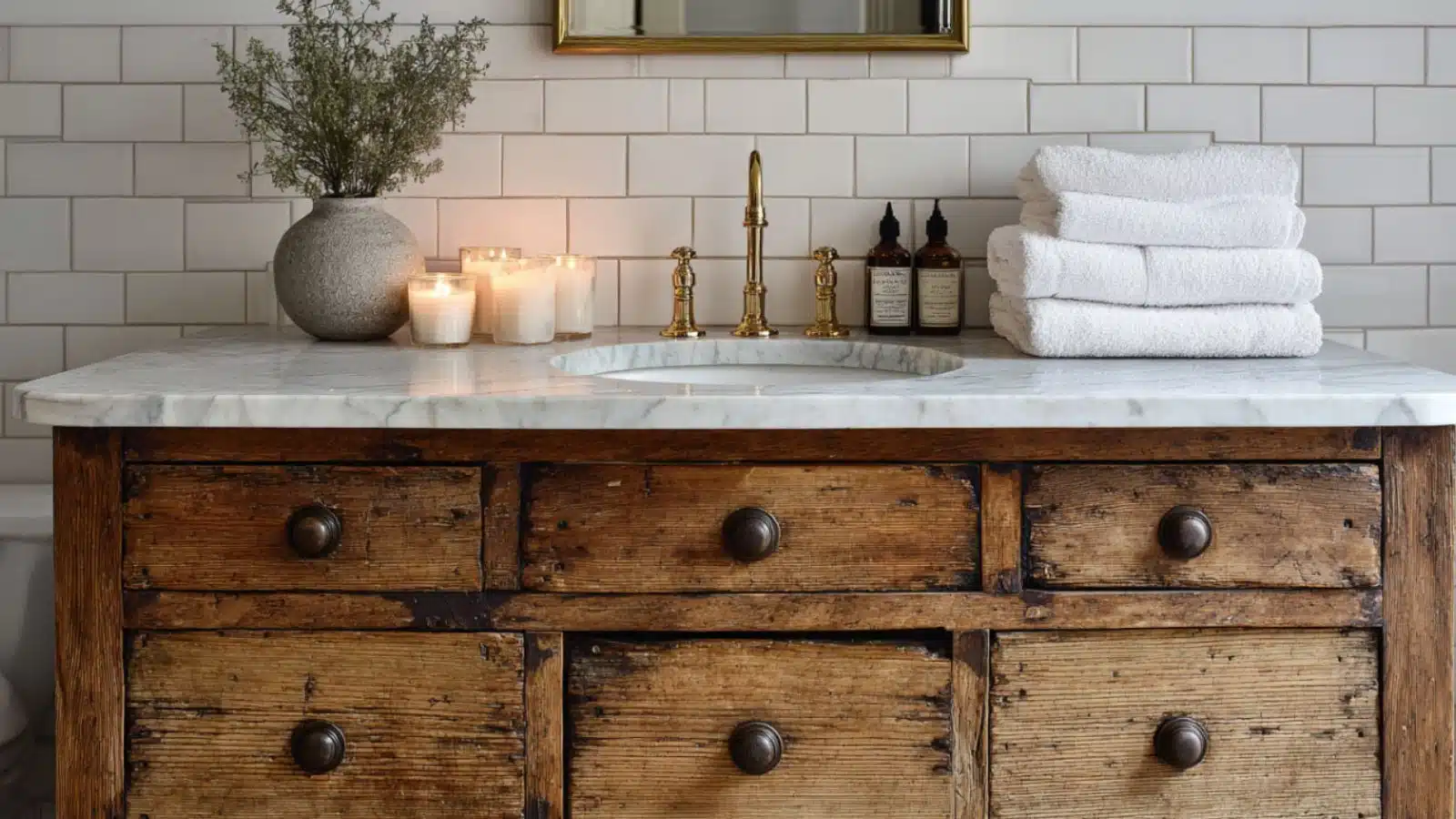Vintage Vanity Ideas Bathroom with Repurposed Furniture
Table of Contents
The modern bathroom is no longer just a utilitarian space—it’s now a canvas for personal expression and curated design. One of the most stylish and sustainable trends gaining momentum is the use of vintage vanity ideas in the bathroom, especially when paired with repurposed furniture. These vanities bring history, charm, and individuality into what is often the most overlooked room in the house.
With a renewed focus on sustainability, more homeowners are opting for one-of-a-kind pieces rather than mass-produced cabinetry. A vintage dresser, antique desk, or even an old sewing table can become the centerpiece of a beautifully designed bathroom. Not only do these pieces reduce waste, but they also allow for customization, offering a mix of function and flair that modern vanities often lack.
In this article, we’ll explore how you can embrace vintage style through repurposed vanities, what to consider in terms of design and functionality, and how to balance old-world charm with everyday practicality. From sourcing the perfect furniture to styling tips that make your space feel cohesive and cozy, you’ll leave with all the inspiration needed to transform your bathroom into a vintage haven.
Choosing the Right Piece: How to Select a Furniture Base for Your Vanity

The foundation of a great vintage bathroom vanity begins with the furniture you choose. Your selection should balance aesthetics with durability and adaptability for plumbing.
Factors to consider when choosing repurposed furniture for a vanity:
| Feature | Considerations |
|---|---|
| Size | Must fit your bathroom layout and allow for plumbing installation |
| Material | Solid wood is ideal; avoid particle board or MDF that won’t withstand moisture |
| Height | Standard vanity height is 32″–36″; adjust legs if needed |
| Storage Potential | Look for drawers or shelves that can still function after sink installation |
| Surface Condition | A sturdy top can be sealed or replaced with marble, granite, or tile |
A charming antique dresser with solid wood drawers, for instance, can be transformed into a rustic-meets-elegant vanity with minimal adjustments. Consider sanding, repainting, or staining the piece to match your aesthetic.
Sink and Countertop Compatibility: Making It Work with Modern Fixtures

Once your furniture base is chosen, the next challenge is integrating plumbing and fixtures. This section blends practicality with aesthetic integrity.
Popular sink and counter styles for vintage vanities:
| Sink Type | Pros | Aesthetic Match |
|---|---|---|
| Vessel Sink | Easiest to install on repurposed furniture | Farmhouse, vintage, eclectic |
| Drop-In Sink | Requires cutting and precision | Transitional, cottagecore |
| Undermount Sink | Sleek finish, requires countertop changes | Traditional, luxury vintage |
If your repurposed piece has a delicate or decorative top, vessel sinks are often the best solution. They require minimal alteration to the structure and can become a design feature themselves.
Creative Paint and Finish Ideas to Match Your Bathroom Theme

Painting or refinishing a vintage vanity allows you to blend it seamlessly into your bathroom’s color palette or let it stand out as a statement piece.
Popular paint and finish styles for repurposed vanities:
| Finish Style | Description | Best for… |
|---|---|---|
| Distressed Paint | Aged look with layers showing through | Farmhouse, shabby chic |
| Matte Black or Navy | Modern edge while maintaining character | Vintage-modern fusion |
| Natural Wood Stain | Preserves grain and detail | Rustic, traditional |
| Chalk Paint | Easy application, velvety matte finish | French country, cottagecore |
Ensure you seal the final finish to protect against moisture and wear. Water-based polyurethanes are popular for bathroom use as they don’t yellow over time.
Vintage Vanity Storage Hacks: Combining Charm with Functionality

While style is key, functionality shouldn’t be compromised. Repurposed furniture can offer clever storage solutions when thoughtfully adapted.
Creative storage ideas with vintage vanities:
| Storage Feature | Solution Ideas |
|---|---|
| Shallow Drawers | Use for makeup, brushes, and daily essentials |
| Open Shelf Base | Add woven baskets for towels and toilet paper |
| Side Compartments | Repurpose sewing machine cubbies or desk trays |
| Hidden Compartments | Create false drawer fronts for plumbing while preserving design lines |
Don’t shy away from mixing old and new. Adding soft-close drawer glides or interior organizers can improve functionality without affecting the external charm.
Mirror, Mirror: Choosing the Perfect Accent to Complement Your Vanity
A well-chosen mirror can elevate your entire vanity area. It should reflect the same vintage spirit while adding elegance and light.
Mirror styles that pair well with vintage vanities:
| Mirror Style | Characteristics |
|---|---|
| Gilded Frame Mirror | Ornate, baroque, or gold leaf frames for drama |
| Arched Top Wood Mirror | Echoes curves in antique furniture |
| Repurposed Window Frame | Rustic, airy option for farmhouse and coastal themes |
| Oval Beveled Mirror | Classic and timeless, perfect for minimalist vintage spaces |
Lighting also plays a key role. Wall sconces on either side of the mirror can enhance symmetry and ambiance.
Repurposing a Dresser into a Double Sink Vanity
Double sink vanities are perfect for shared bathrooms, and a sturdy vintage dresser can offer a spacious and stylish foundation. Start by choosing a dresser that is at least 60 inches wide to accommodate two sinks with enough counter space between.
Steps for transforming a dresser into a double sink vanity:
| Step | Description |
|---|---|
| Measure and Plan | Mark where plumbing lines will go. Choose the sink and faucet placement. |
| Reinforce Frame | Remove inner drawers if needed, and reinforce structure to support sinks. |
| Cut Holes | Use a hole saw for faucet and drain placements. Ensure spacing works. |
| Add Countertop | Replace top with stone or tile for water resistance and modern appeal. |
| Seal and Finish | Apply waterproof sealants, and refinish the outer body to your preference. |
This DIY project allows you to maintain original drawer fronts as faux panels for plumbing concealment while converting the remaining drawers into usable storage. It’s a blend of craftsmanship, charm, and clever design.
Sourcing Vintage Furniture for Bathroom Projects
Finding the perfect piece is often the most exciting—and sometimes challenging—part of the process. You want something with character, but also with enough structural integrity to handle a bathroom conversion.
Best places to find vintage furniture for repurposing:
| Source | Tips for Selection |
|---|---|
| Local Antique Shops | Test drawer function and stability; ask about wood type |
| Facebook Marketplace | Search “dresser,” “buffet,” or “vanity base” in your area |
| Estate Sales | High chance of solid wood craftsmanship and unique pieces |
| Thrift Stores | Inexpensive, but inspect for mold, rot, or veneer damage |
| Flea Markets | Haggle-friendly and often full of surprise finds |
Once you find your piece, check for signs of previous water damage or woodworm. You can often salvage minor issues with sanding, patching, and sealing, but solid construction is key for long-term durability in a humid environment.
Conclusion
Embracing vintage vanity ideas with repurposed furniture allows you to break free from cookie-cutter designs and infuse your bathroom with soul, sustainability, and charm. Whether you choose a delicate French provincial dresser or a rugged farmhouse workbench, your vanity can become a functional work of art.
With thoughtful planning, attention to detail, and creative styling, a repurposed furniture vanity can offer just as much (if not more) practicality than traditional store-bought options. It’s a small renovation that delivers big personality—one drawer, mirror, and faucet at a time.

